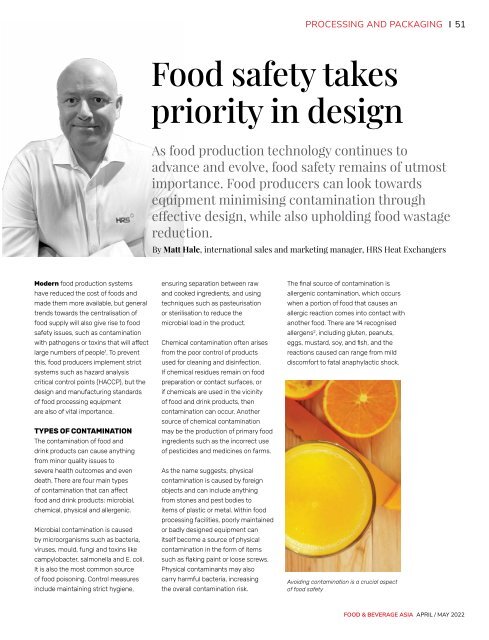Food & Beverage Asia April/May 2022
Food & Beverage Asia (FBA) is the leading source of food and beverage news in Asia since 2002. FBA delivers a comprehensive view of the food and beverage landscape, spanning across the latest health and nutrition trends and industry innovations in ingredients, recipe formulations, food science, sustainability, packaging, and automation, as well as advancements in agri and food-tech.
Food & Beverage Asia (FBA) is the leading source of food and beverage news in Asia since 2002. FBA delivers a comprehensive view of the food and beverage landscape, spanning across the latest health and nutrition trends and industry innovations in ingredients, recipe formulations, food science, sustainability, packaging, and automation, as well as advancements in agri and food-tech.
You also want an ePaper? Increase the reach of your titles
YUMPU automatically turns print PDFs into web optimized ePapers that Google loves.
PROCESSING AND PACKAGING 51<br />
<strong>Food</strong> safety takes<br />
priority in design<br />
As food production technology continues to<br />
advance and evolve, food safety remains of utmost<br />
importance. <strong>Food</strong> producers can look towards<br />
equipment minimising contamination through<br />
effective design, while also upholding food wastage<br />
reduction.<br />
By Matt Hale, international sales and marketing manager, HRS Heat Exchangers<br />
Modern food production systems<br />
have reduced the cost of foods and<br />
made them more available, but general<br />
trends towards the centralisation of<br />
food supply will also give rise to food<br />
safety issues, such as contamination<br />
with pathogens or toxins that will affect<br />
large numbers of people 1 . To prevent<br />
this, food producers implement strict<br />
systems such as hazard analysis<br />
critical control points (HACCP), but the<br />
design and manufacturing standards<br />
of food processing equipment<br />
are also of vital importance.<br />
TYPES OF CONTAMINATION<br />
The contamination of food and<br />
drink products can cause anything<br />
from minor quality issues to<br />
severe health outcomes and even<br />
death. There are four main types<br />
of contamination that can affect<br />
food and drink products: microbial,<br />
chemical, physical and allergenic.<br />
Microbial contamination is caused<br />
by microorganisms such as bacteria,<br />
viruses, mould, fungi and toxins like<br />
campylobacter, salmonella and E. coli.<br />
It is also the most common source<br />
of food poisoning. Control measures<br />
include maintaining strict hygiene,<br />
ensuring separation between raw<br />
and cooked ingredients, and using<br />
techniques such as pasteurisation<br />
or sterilisation to reduce the<br />
microbial load in the product.<br />
Chemical contamination often arises<br />
from the poor control of products<br />
used for cleaning and disinfection.<br />
If chemical residues remain on food<br />
preparation or contact surfaces, or<br />
if chemicals are used in the vicinity<br />
of food and drink products, then<br />
contamination can occur. Another<br />
source of chemical contamination<br />
may be the production of primary food<br />
ingredients such as the incorrect use<br />
of pesticides and medicines on farms.<br />
As the name suggests, physical<br />
contamination is caused by foreign<br />
objects and can include anything<br />
from stones and pest bodies to<br />
items of plastic or metal. Within food<br />
processing facilities, poorly maintained<br />
or badly designed equipment can<br />
itself become a source of physical<br />
contamination in the form of items<br />
such as flaking paint or loose screws.<br />
Physical contaminants may also<br />
carry harmful bacteria, increasing<br />
the overall contamination risk.<br />
The final source of contamination is<br />
allergenic contamination, which occurs<br />
when a portion of food that causes an<br />
allergic reaction comes into contact with<br />
another food. There are 14 recognised<br />
allergens 2 , including gluten, peanuts,<br />
eggs, mustard, soy, and fish, and the<br />
reactions caused can range from mild<br />
discomfort to fatal anaphylactic shock.<br />
Avoiding contamination is a crucial aspect<br />
of food safety<br />
FOOD & BEVERAGE ASIA APRIL / MAY <strong>2022</strong>


















